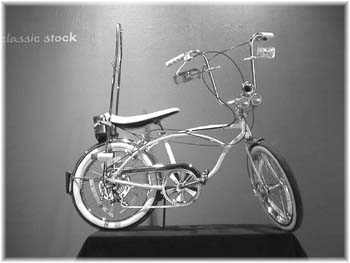![[Metroactive Arts]](/arts/gifs/art468.gif)
![[Metroactive Arts]](/arts/gifs/art468.gif)
[ Arts Index | Metro | Metroactive Central | Archives ]
Low Bikes, High Art
Where There's a Wheel, There's a Way: Even at rest, the artfully customized lowrider bicycles in MACLA's new show look like they're going somewhere in a hurry.
A new show at MACLA spotlights the serious style of lowrider bicycles
By Ann Elliott Sherman
NOT EVERY ARTIST gains recognition, not every work finds its audience or stage. Creators of lowrider cars and bicycles know this truism. No waiting for the solo show at a big-name gallery or acceptance for publication is required--their chosen art form by definition takes them places where the reaction from the public is instantaneous and immediate, from slow-tracking stares to getting pulled over by the cops.
Lowrider Bicycles: Art and Identity Among Mexican-American Youth at MACLA/the San José Center for Latino Arts does for the customized bike what New York's Museum of Modern Art has done for designer chairs and cookware, to name just two categories of reimagined functional objects in MOMA's design collection--it takes the bikes out of the garage or street and examines them on aesthetic and cultural terms.
Rather than a historical retrospective, the show takes a sociological slant and spotlights a variety of local devotees, their bikes and their motivations for customizing. Huge black-and-white photos of the featured artists hang floor to ceiling next to their low-slung rides. This touch borrowed from stage-set or retail-display design emphasizes the bicycle as an expression of individual identity, while the bikes' adherence to the visual ideals of the genre demonstrates their function as a subcultural symbol.
The aesthetic, like that of Fabergé eggs, is simultaneously reductive and baroque--a magical realization of exaggerated lines, flashily decorative finishes and strategically selected (Sch)winning accessories. An outsider attitude drives the design, at least in part; it is the sense that since the powers that be are going to be watching every move you make, you might as well put on a show.
The nose-thumbing infusion of over-the-top style isn't for everyone--and that's the point. Daring to stand out rather than submissively fade into the background, as perhaps their grandparents were taught, lowrider aficionados took a gangsta lean from the pachuco and rode the wave of Chicano pride.
By now, lowriders have become a cultural icon; Mom and Dad might have retired from cruising themselves, only to show Junior how to sling the bondo and air brush. Lowrider Bicycles underscores the family and club dynamics inherent in becoming involved with low bikes, featuring artists often related by blood or marriage and highlighting the passing of the torch from parents to kids in the artists' testimonials.
Orange Sunshine, the 1977 creation of Marcos Gaitan's family and friends, epitomizes the intergenerational cultural exchange. With a cantilever frame inspired by a mint-condition magazine cover of a street chopper, the bike demonstrates a sophisticated unity of color and line.
Sharply angled handlebars echo the framework. The rich coppery-orange frame features brown panels supporting a delicate gold filigree motif. A parallel border of red striping that occasionally intersects the panels accentuates the frame's shape and points of connection. The curved golden detailing is continued throughout--rims, handle grips (themselves threaded with slender chainlinked gold) and satin, tufted banana seat trimmed with brown braid. No wonder Marcos chose a career in art.
STANDING on a gilt-edged mirror spread with shiny gold tinsel, Willie Galván's lowrider bike might be dubbed Reflections in a Golden Eye. Virtually every piece of metal (spokes and derailleur included) has been given the Midas touch; a tiny chain steering wheel makes the link between lowrider bicycles and their four-wheeled counterparts.
Interestingly, the female lowrider enthusiasts in the exhibition stick to the higher "street custom" profile instead of ground-hugging body modifications. Perhaps turning heads by defying one gender stereotype is enough--a literally laid-back female might just trigger a different set of dated macho assumptions.
Angel Salvatore favors an understated, pearly elegance, adding zip with a soaring sissy bar and inlaid mother-of-pearl chain guard. Her sister, Andrea, selects cunning accessories for her red-and-white Schwinn: a matching bicolor headlight/AM radio and the edgier addition of bullet-shaped wheel lights and inner-tube cap.
Fellow visitor Emiliano Banderas, himself a customizer and professional artist, appreciated the show for elevating low bikes to the status of art but expressed skepticism about its lack of candor about the "other side" of the subculture that isn't always so wholesome, with ties to gangs and drugs. Participating artists Gaitán and Angel Salvatore both allow that the actions of "certain punks" give lowriders a bad rep.
Whether accentuating low bikes' importance as an art form and offering an alternative to the dominant bad-boy image of lowriders is the same as whitewashing is open to debate. Banderas and I agreed, however, that the standout of the show just might be young Julian Rodriguez's beautifully crafted bike.
A very low-slung number with the seat resting right on the rear chrome fender, this bike is set apart by its elongated, flaring line, from the tip of the upturned front fender to the stretched curve of the sissy bar extended way beyond the back wheel.
The handlebars, the swirling pattern of the crushed-velvet seat and especially the marbled-by-force-of-nature paint job--"a black base, with pearl silver and then candy-apple red blown with the airbrush," Banderas explained--all continue the sinuous arc of the baby-smooth frame and make the sleek bike seem to be slicing through the air even while standing still. Going with the flow never looked so good.
[ Metro | Metroactive Central | Archives ]
Copyright © Metro Publishing Inc. Maintained by Boulevards New Media.

Christopher Gardner
Lowrider Bicycles: Art and Identity Among Mexican-American Youth runs through Oct. 11 at MACLA/San José Center for Latino Arts, 510 S. First St., San Jose. (408/998-2783)
From the Sept. 25-Oct. 1, 1997 issue of Metro.